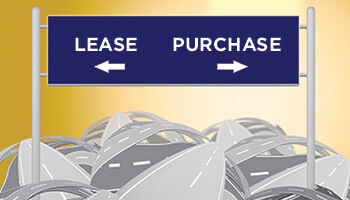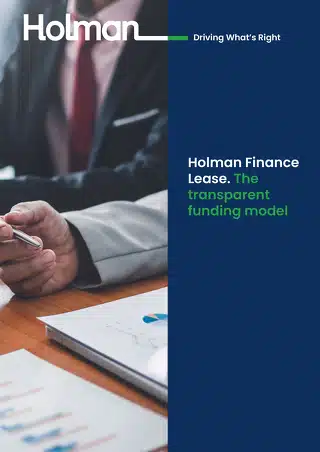-
What We DoFrom fleet management and productivity solutions to upfitting, fabrication, and insurance, Holman has the integrated automotive services expertise to keep your business moving.Overview
-
ResourcesWe have a lot to share. Browse our resources library for current insights, data, strategies, and success stories from our own experts in their respective fields.Overview
-
About UsWhen Holman was founded in 1924, we set something positive in motion. Our consistent focus on people and our commitment to integrity make us who we are today.Overview
 Join Our TeamWe’re not just in the automotive business, we’re in the people business. Join us for the ride.Browse Careers
Join Our TeamWe’re not just in the automotive business, we’re in the people business. Join us for the ride.Browse Careers
Avoiding Silofication – Lease vs. Purchase
Holman Marketing
October 4, 2022

This year more than ever before, uncertainty throughout the entire supply chain is forcing most businesses to adjust their annual ordering and budget planning process. The supply chain has explicitly been hit hard by changes during the pandemic, with parts and shipping shortages creating a bottleneck that hurts every aspect of the process. Still, despite these setbacks, there is progress, with often the conversation being: Should we lease, finance, or purchase, our vehicles?
To begin to answer this question, here are a few essential considerations to keep in mind, as well as some initial conversation starters to help guide your decision-making process.
Separate Facts from Myths
For many organisations, there’s always been a perceived fear of leasing, a myth that you would end up paying more in terms of the total cost of ownership (TCO) than owning a vehicle outright. Fortunately, advanced analytics are helping to change that perception by transforming your fleet data into actionable insights that highlight the true TCO for each acquisition scenario.
Today, leasing, purchasing, and financing are all viable options when it comes to acquiring vehicles for your fleet.
For some companies, purchasing or financing vehicles may be the best way to invest capital directly into your business, but this can also restrict cash flow. For others, leasing may be a more attractive option, as lower payments allow you to maintain liquidity and retain capital for other investment opportunities. And in many scenarios, a hybrid solution comprised of both purchasing and leasing vehicles may provide significant benefits for your organisation.
Don’t be fooled by myths as you decide to lease, finance, or purchase your vehicles. Trust the facts (i.e., data), ignore the myths, and treat your fleet just as you would any other strategic business asset to determine which option(s) delivers the most value for your organisation.
What’s Best for Your Business?
Remember, there’s no one-size-fits-all approach for vehicle acquisitions. Your business is unique, which makes every acquisition-related decision just as distinctive. Leasing, financing, or purchasing vehicles impact your company’s fiscal future in different ways. You’ll need to carefully weigh the pros and cons of each when developing your acquisition strategy.
As you work to determine what’s best for your organisation, answering these key questions will help to guide your decision-making process:
- Do I have any potential budget constraints or other financial limitations to navigate?
- How will our acquisition strategy impact our business’ cash flow or operating capital?
- Are there any rules, regulations, or credit challenges that may limit our options?
- What are the operating conditions of our vehicles (miles driven, wear and tear, etc.)?
- How does our acquisition strategy align with and support the overarching goals of our business?
You’ll also want to be sure to consider how vital vehicle reliability is to your business. If uptime and productivity are of paramount importance, your fleet will likely benefit from shorter lifecycles that tend to favour leasing. While acquisition costs will probably be slightly higher, the lower operating costs often associated with newer units will help to offset this initial investment.
On the other hand, if your fleet includes several costly, highly specialised vehicles, it may best serve you to spread this capital investment over an extended lifecycle which may favour purchasing/financing. But there are undoubtedly additional factors to consider. Most notably, you’ll likely incur higher operating costs and lower productivity as the unit ages, making proper preventative maintenance much more vital to maximising reliability.
Break Out of the Silos
Perhaps more than ever before, there are several stakeholders from across your entire organisation – budgeting, procurement, operations, etc. – who influence your organisation’s acquisition strategy. As you reassess your strategy, ask yourself: Are all these stakeholders on the same page or operating in isolation, blind to how their actions impact the overall process?
If you let these blind spots linger, you risk exposing your fleet to several hidden flaws that will reduce productivity, increase costs, and hamper your acquisition strategy. Instead, take this opportunity to align all stakeholders, eliminate the silos, and embrace a holistic fleet solution that addresses the entire lifecycle – buy, drive, service, and sell.
And as always, remember we’re here to help you navigate these challenges, understand the variables, and help you determine the best strategy to keep your business moving forward.
Read more about how thinking about your fleet strategically will help you maximise your investment, or contact us today to discuss your specific needs in more detail.
Related Resources
Explore more related industry news, insights, and developments.







